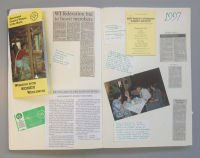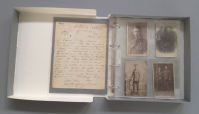Creating a scrapbook is a great way of collecting family memories, or recording the history of a village or a special event. Since the purpose of the scrapbook is usually to provide a permanent record to pass down to future generations, it is important to use materials that are stable and long-lasting. The album should also be able to hold an assorted collection of archival and ephemeral material.
What can I put in it?
 Photographs: These are very precious items and need extra protection. If possible, use a copy of the photograph in the album and keep the original in an archival folder and box in a cool dark place. There
are several ways to display album photographs:
Photographs: These are very precious items and need extra protection. If possible, use a copy of the photograph in the album and keep the original in an archival folder and box in a cool dark place. There
are several ways to display album photographs:
- archival mounting corners on acid free mounting pages
- individual clear archival polyester sleeves secured to the page with pressure sensitive tape on the back
- archival polyester pocket pages. These allow you to view any written information on the back of the photograph
Postcards: These are in many ways similar to photographs and should be stored and displayed in the same way.
News cuttings: These will soon become discoloured and brittle, so make photocopies on archival photocopy paper and use instead of originals. Re-arrange oversized articles by cutting between the columns and lines of type. Stick the sections onto a standard A4 paper before making an archival copy.
Programmes and pamphlets: These items can become badly torn or creased when pasted into an album. They should be placed in a clear archival polyester pocket page, so they can be easily removed from the pocket for viewing.
Letters and documents: Folded paper documents should be opened carefully and flattened under a weight (use a large book or two). Do not try to repair any tears in the paper. Place each page in a single archival polyester pocket page to protect vulnerable and damaged areas of the paper and allow safe and easy viewing.
Medals and textiles: Avoid displaying any bulky, oversized or valuable items. Instead take photographs for the album and store the originals in a safe place.
What materials should I use?
 Materials used in non-archival scrapbooks may be acidic and chemically unstable and could permanently damage the displayed items. Archival-quality albums are available from specialist suppliers, usually as a ring
binder file. This allows the freedom to move or add custom-made archival quality paper pages and single or multiple polyester pocket pages. The album should include a slipcase, box binder or a separate box to protect the contents from light damage and atmospheric pollutants.
Materials used in non-archival scrapbooks may be acidic and chemically unstable and could permanently damage the displayed items. Archival-quality albums are available from specialist suppliers, usually as a ring
binder file. This allows the freedom to move or add custom-made archival quality paper pages and single or multiple polyester pocket pages. The album should include a slipcase, box binder or a separate box to protect the contents from light damage and atmospheric pollutants.
The following tips should ensure your scrapbook endures:
Use neutral pH adhesive to avoid any unsightly and damaging stains.
Archival acid free mounting corners provide a safe and effective method of displaying photographs and postcards.
For making discreet notes on the album page, there is a range of pens for paper and polyester. The inks do not fade and are resistant to light and water. Use archival photocopy paper when making copies. Store the album in a cool dry place.
A list of suppliers of materials and equipment is available.

